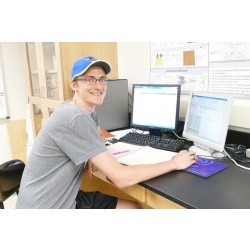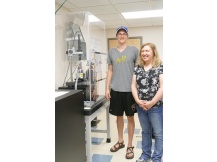
decorahnews.com feature: A big project involving very tiny objects
As technology continues to produce smaller items, there is a greater need to understand how smaller objects wear.
Luther College senior Jared Barnes from Fort Worth, Texas, is researching and analyzing the effects of nanoscale wear for his summer research project at the college.
Barnes is analyzing data taken with an atomic force microscope, which uses a flexible diving board with a nanoscale tip at the end. The end of the tip is nanoscale-sized, meaning that it has a size about a thousand times smaller than the width of a human hair. The atomic force microscope tip is intentionally worn so the wear can be monitored and quantified.
Car sensors and cellphone parts are among objects that are required to withstand certain amounts of nanoscale wear. By knowing the effects of wear on nanoscale objects, the objects can be designed to be more durable and continue to work without breaking. Barnes has written computer code to perform calculations of wear, which will help him and Luther College Professor of Physics Erin Flater to better understand nanoscale wear behavior.
Barnes, the son of Kathi Daniel of Fort Worth, Texas, and David Barnes of Arlington, Texas, is a 2014 graduate of Arlington High School and majoring in physics at Luther. "Research has taught me a lot about how I can learn things on my own without the help of others. I've always asked a lot of questions, but research has given me the confidence to be creative and bold in my approach to solving problems," said Barnes.
The Student-Faculty Summer Research projects provide students an opportunity to research topics of interest alongside Luther faculty. This program is one of a wide selection of experiential learning opportunities at Luther intended to deepen the learning process and that are part of Luther's academic core. The results of the project will be presented at the end of fall 2017 in his senior project presentation.
Barnes favorite part of research is when there is a problem, or something looks like it's going to take days and weeks to figure out. "Then you write some computer code to do it for you, spend a day on it, really get into it and then you have the computer do all that crazy stuff for you. You end up solving it in 10 minutes when you are done."
The overarching goal for Barnes is to better understand how things wear away. "Understanding the principles that go into how things wear away on a small scale, or on a large scale, so I can understand the principles going on behind it," he added.
Barnes will graduate from Luther in December and has applied for an internship with Engineering Missions International for the spring. EMI's mission is to develop people, design structures, and construct facilities which serve communities and the Church.
EMI's website states, "In a world of physical and spiritual poverty, EMI designs a world of hope. We are a Christian ministry that designs facilities that serve the poor in developing countries. These facilities (including hospitals, orphanages, schools, clean water projects and more) directly impact communities by meeting physical needs and communicating God's love in a practical way."
"I think that is the perfect place for me to be, where my faith and passions lie," said Barnes. After Barnes' internship he plans to attend graduate school for mechanical engineering in Texas, his home state.
Site designed and maintained by Iroc Web Design Services©.
Your Small Business Web Design Solutions.™




